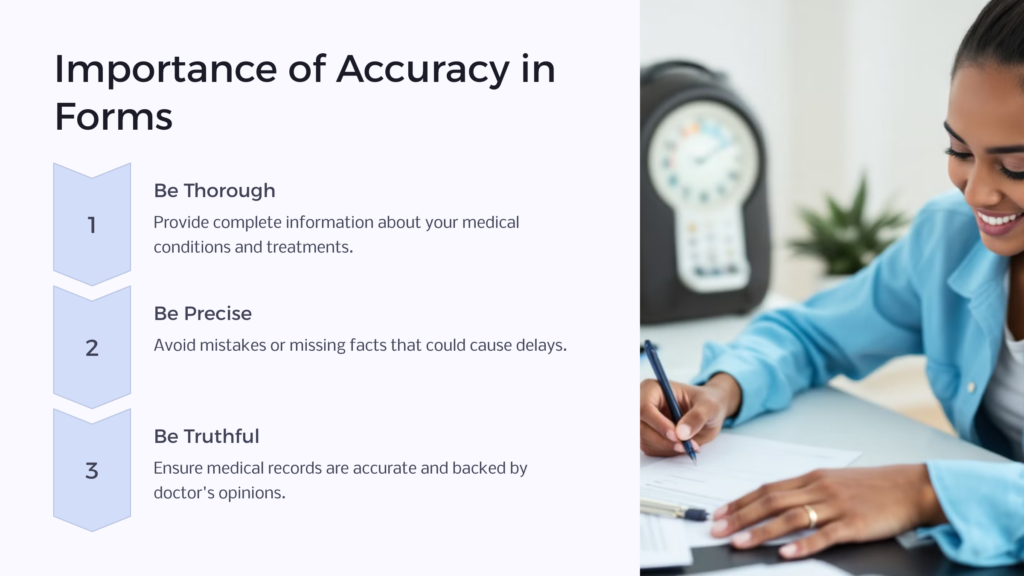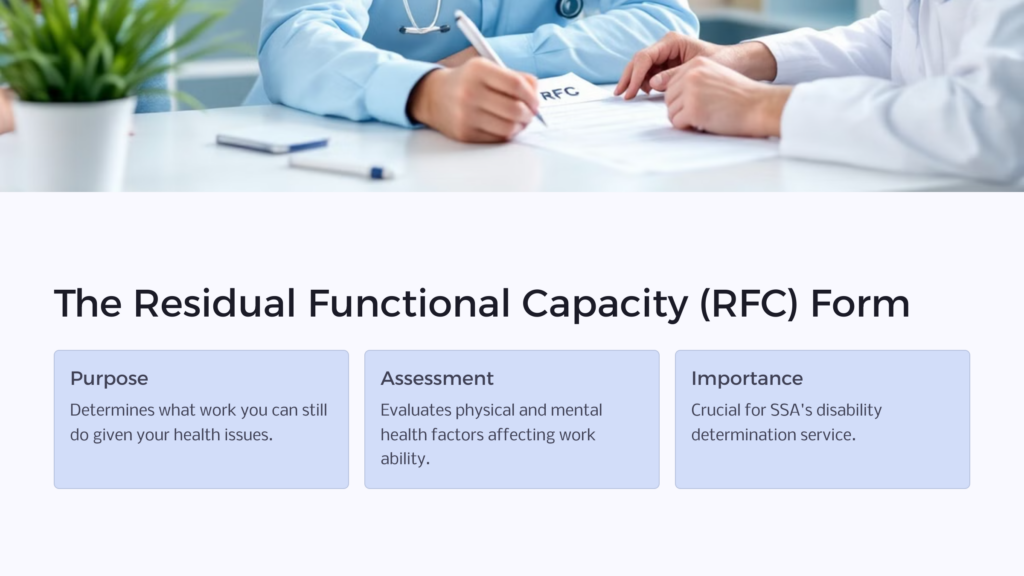When it comes to social security disability insurance, there is a lot of disability paperwork involved in the application process. Don’t let this overwhelm you! We’ll walk you through it and focus here on social security disability forms for doctors to fill out, and how these can better your chance of SSDI approval.
The Crucial Role of Doctors in the SSDI Application Process

Doctors act as key supporters in your SSDI journey. Their medical expertise proves how severe your condition is, and the Social Security Administration (SSA) needs to see this before approving your case. Your doctor advocates for you when offering strong medical evidence to back up your SSDI application.
Your physician’s views matter when proving your need for SSDI benefit. They offer a thorough medical record—including accurate diagnoses, clear treatment plans, and detailed analysis of your functional limitations. All this shows how your condition affects your life and your ability to work.
You could give this same information yourself, but an expert ensures fairness and reliability. A doctor’s judgments are based on a deep understanding of your medical condition. This keeps the records true to the patient’s situation. Working together, you and your doctor can give a full picture of your medical challenges, which helps the SSA make the right decisions about SSDI.
Required medical involvement protects the program’s integrity. It is a sure measure that helps those who truly need support to receive it. In short, a doctor’s role is more than just filling out forms. They will advocate for your well-being and help you get the social security benefits you need.
The Essential Forms for SSDI Application
To start your SSDI application, get to know the key forms that make or break your case. These social security forms do more than prove eligibility; they give a full view of your medical situation, past treatments, and your work history report. Being thorough will always increase your chance of SSDI approval.
The SSA-16-BK form, or “Application for Disability Insurance Benefits,” collects information such as contact details, Social Security number, and job history. The SSA uses this data to check basic eligibility requirements. For example, if you’ve paid into Social Security, and your current amount of work credits.
Another helpful form is the SSA-3368, or “Disability Report – Adult.” This form deep-dives into your conditions, treatments, and your work history report. The SSA advises you to be detailed about your health issues, when they started, how they’ve changed, and who’s treating you.

Accuracy is key for both forms. Every fact you give helps the Social Security Administration understand you better. Mistakes or missing facts will likely cause delays or problems later on. Medical records should be complete and truthful, backed up by your doctor’s expert opinions. How you fill these forms may determine the SSA’s understanding of how to help you.
By handing in these social security disability forms, you’re giving the SSA a snapshot of your life—it’s your chance to present your case. Forms like SSA-16-BK and SSA-3368 aren’t just paperwork; they show your real need for help through clear and complete information. You can fill out this paperwork either at your local social security office or online through the SSA website. Submitting a social security disability claim online is easy and typically yields faster results.
Securing Medical Authorization: What Doctors Need to Fill Out

Doctors are charged with the Residual Functional Capacity (RFC) form and submitting accurate medical records. This disability form is a big deal in figuring out what kind of work you can still do, given your health issues. It helps the SSA get a full picture of what you can and can’t do, and plays a big role in their disability determination service.
The RFC includes an assessment of your physical and mental health. Your doctor will judge key factors that affect your ability to work. These include mobility, strength, stamina, pain tolerance, and mental ability at work.
Understanding your health condition and how it affects your life and work is crucial for filling out this form. Your doctor takes all their medical know-how to judge how your health interacts with the needs of potential jobs.
The RFC gives the SSA an evidence-based, fair view of what you can and can’t do. It’s a key part of deciding if you qualify for any SSDI benefit program. This form is central to the entire approval process, adding a lot of the data used to figure out if you can work enough to support yourself.
In short, the RFC form is an unbiased, standard way to judge your work abilities and limits. Your doctor’s seasoned judgment gives the SSA the clear info they need to make smart decisions. This teamwork between doctors and the SSA makes sure the review is not just about your health, but also about how it affects your ability to work and make a livable income.
Tips for Navigating the SSDI Application Process
To boost your chances of getting SSDI benefits:
- Ensure all your forms are filled out correctly and completely. Gather all the personal details, job history, and health records you need. Follow each form’s instructions closely.
- Keep your answers short and clear. If you run out of room, it’s okay to use extra sheets—just make sure your writing is easy to read.
- Double-check everything; mistakes could slow things down or even get your application denied.
- Keep a copy of your full application, just in case.
Remember that the review process can take a while, so be patient.
Your Benefits Journey

From understanding key forms like the SSA-16-BK and SSA-3368 to securing crucial medical assessments, each step is vital. Staying accurate, thorough, and patient throughout the process can make a significant difference in your application’s success.
Eligibility depends on various factors—your medical condition, job history, and Social Security contributions—but specialized help is available.
If your initial application gets denied, remember that filing an appeal is possible. Navigating the SSDI application process can be complex, but you’re not alone. If you’re looking for guidance to make your disability benefits journey smoother, don’t hesitate to contact us at Benefits.com. We’re here to assist you every step of the way.
 Benefits.com Advisors
Benefits.com Advisors
With expertise spanning local, state, and federal benefit programs, our team is dedicated to guiding individuals towards the perfect program tailored to their unique circumstances.
Rise to the top with Peak Benefits!
Join our Peak Benefits Newsletter for the latest news, resources, and offers on all things government benefits.




















